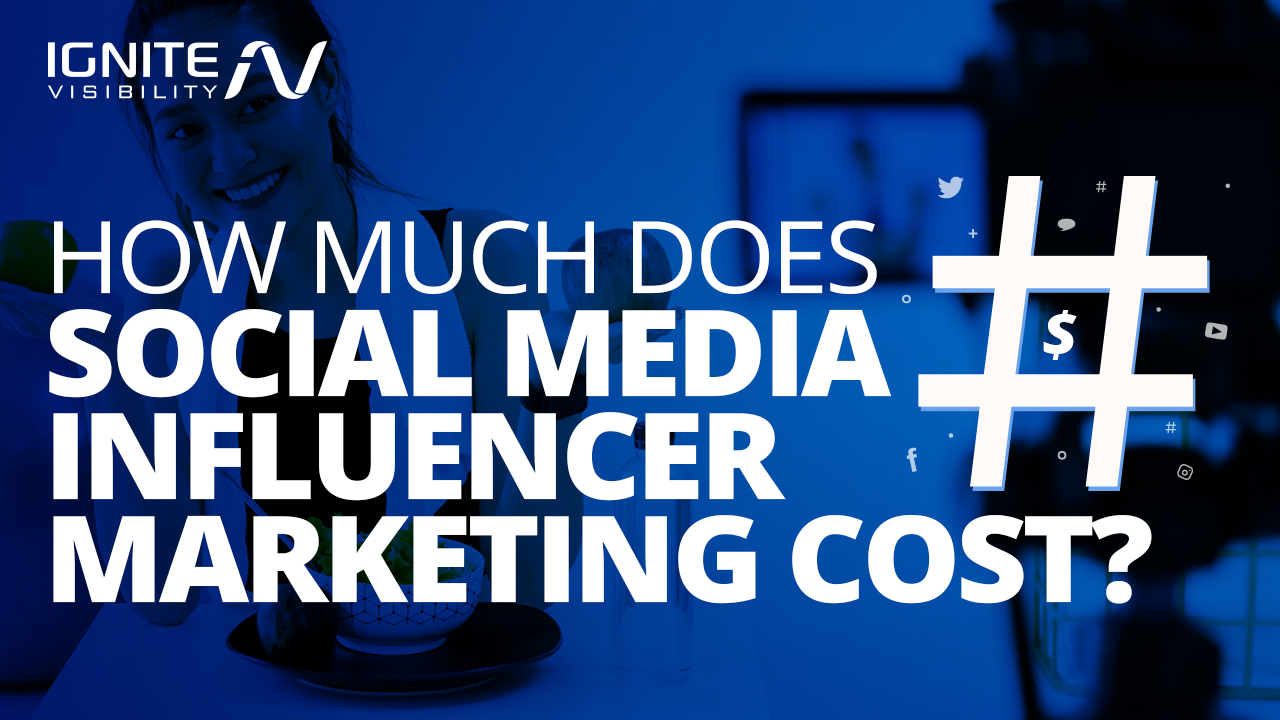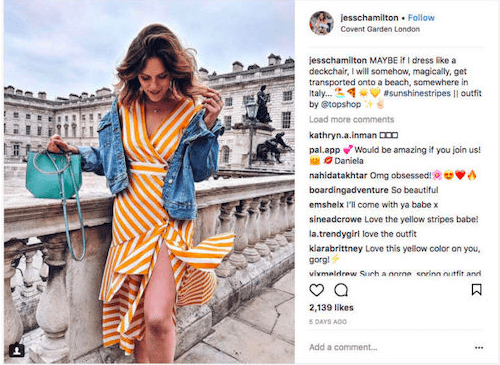Wondering how much influencer marketing really costs?
To answer that, you need to really dive into the scope of the campaign.
In this post, I’ll share some tips and guidelines to help you determine what your influencer campaign should be costing you.
What We’ll Cover:
- Is influencer marketing ever free?
- Factors that influence costs:
- Costs by channel:
- Other considerations
- FAQ
Social Media Influencer Pricing
In 2020, influencer marketing costs have gone up to a range of $1,000 to $1 million per post!
I know, yikes.
But if you’re struggling with calculating social media influencer marketing costs, just keep in mind that a well-run campaign can earn you a very positive return.
That’s because influencer marketing has emerged as one of the best ways to connect with customers.
It’s not exactly a secret that consumers’ trust in brands has been on the decline, and they’re turning more and more to authentic, word-of-mouth recommendations when making buying decisions.
Research by Neilsen backs that up. They found 83% of Americans somewhat or entirely trust endorsements and recommendations from people they know.
And in the end, Sway Group reports that marketers who implemented an influencer marketing campaign earned an average of $6.85 in media value for every $1 they spent on paid media.
But as marketers, the first step in determining your costs is making sure you have a plan in place for tracking and measuring your influencer ROI (you can read all about how to do do that here).
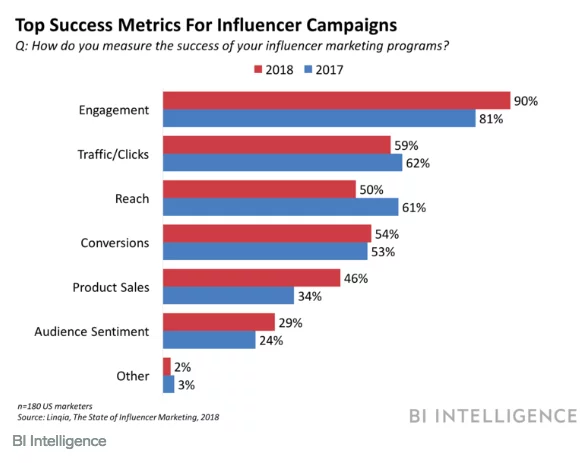
Social media influencer marketing: top success metrics
Is Influencer Marketing Ever Free?
There are some instances where an influencer doesn’t cost anything at all.
At least, not monetarily.
Sometimes, an influencer will be happy to push your product or let you use some of their user-generated content.
But remember, few things in life come completely free. And in terms of social media influencers, the price of a “free” agreement is usually a product trade.
This kind of agreement is much more common in the B2C space, particularly among lifestyle and fashion brands. Brands often provide an influencer free samples of its product – often before the release date – and ask them to review the product.
You’re almost guaranteed to see a spike in traffic if you take this route.
The caveat here is that you don’t always have control over what the influencer might say or the option to review the post/video/story before it goes live.
And if you run a B2B, it’s much harder to come to this sort of agreement, as most industry experts don’t provide their insights for free.
SproutSocial put together a great breakdown of the pros and cons here:
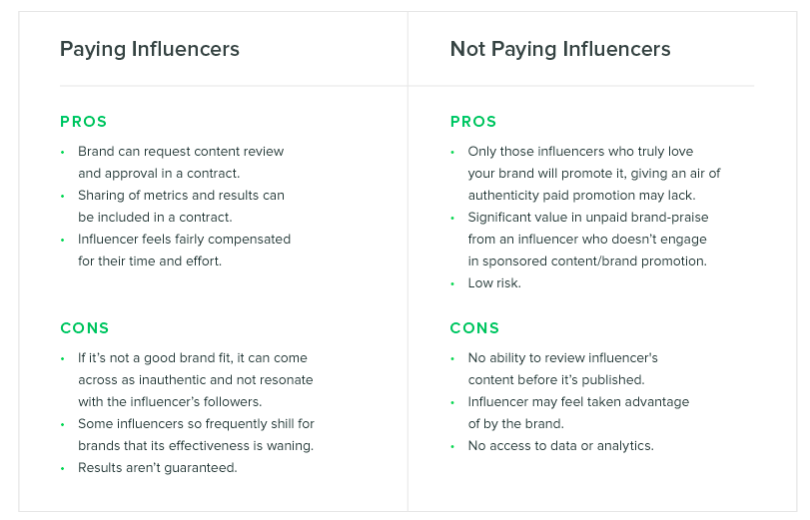
The Pros and Cons of Paying Social Media Marketing Influencers
In most cases, you’ll likely find yourself paying your influencer for their original content.
Factors That Affect Influencer Marketing Costs
When determining overall costs, there are a few factors to take into consideration.
1. Social Platform
As we’ll cover shortly, the platform you choose will have a huge impact on how much you end up paying an influencer.
Keep in mind here, the number of channels used will also have an effect on pricing.
For example, some deals are made exclusively for promotion on a specific platform like Instagram, while others may want to cross-promote content across multiple channels.
The more channels used, the more you’re likely to pay.
2. Following
This is another big one.
For obvious reasons, the larger an influencer’s following, the more expensive they’re likely to be.
Take celebrities. They generally have huge followings and drive high costs.
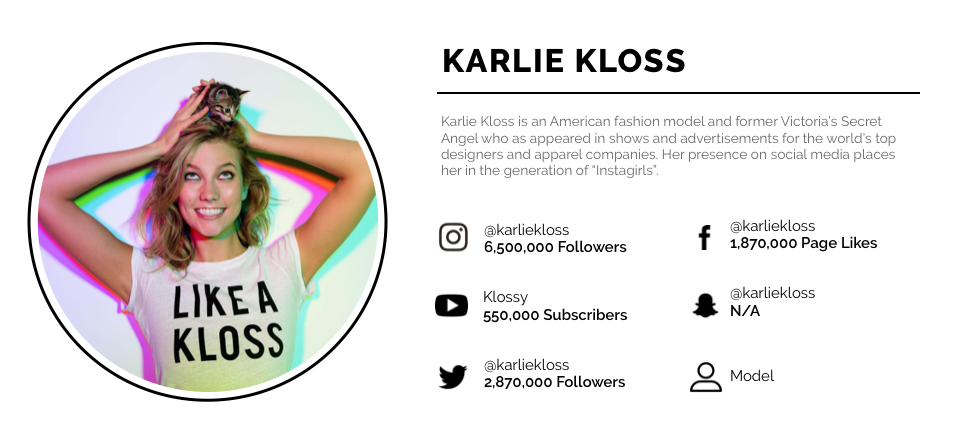
Some of the highest paid social media influencers are celebrities
But that doesn’t mean that enlisting the aid of the Selena Gomez’s out there is the best bet for your business.
Often, a huge follower number doesn’t equate to quality followers. And if their audience isn’t in line with your brand, your message won’t resonate – no matter how many people hear or see it.
For most brands, it’s best to stick with micro-influencers. They tend to have smaller follower counts, but their audience is like-minded and more readily influenced based on similar interests.
Because they’re smaller, they cost less. And because they have a closer relationship with their audience, a brand recommendation will resonate more.
In marketing, that’s what we call a win/win.
3. The Scope of Work
Are you providing the content? Or will the influencer be supplying it?
Are we talking static images or full videos?
This will also have to do with the quality of posts this person typically produces. If they continuously provide high-quality, edited videos, and spend time going through product reviews, etc., it stands to reason that they would cost more than a product placement shot.
Also included in the scope are how many posts you expect and the frequency you want them posted.
The quality and overall scope of work required by the influencer will have a definite effect on what their costs end up being.
4. Exclusivity and Usage Rights
On the more technical side, you have to give some thought to the contract agreements you intend to make with influencers.
Some brands may not want the influencers they partner with working for competitive brands during the campaign.
If that’s so, you’ll have to take the duration of the campaign into consideration. You can expect to pay more for exclusive access to that influencer for that period of time.
Another factor to be aware of is your overall access to the influencer’s content. If they’re creating content for your brand, you may have to pay more for rights to that content after the campaign has ended.
5. Direct Partnership Vs. Agency
And lastly, you’ll have to factor in any extra costs associated with finding and contracting your influencer.
If you’re finding them on your own and negotiating your own contract, you’ll likely pay less.
But if you work through an agency, you’ll have commissions and agency fees to contend with.
Similarly, influencer marketing tools like RewardStyle and Onalytica often come with hefty monthly subscription fees for influencer discovery, management tools, and reporting.
Influencer Pricing By Channel
So, what’s the bottom line? How much does influencer marketing cost per post?
Again, no two influencers are exactly alike.
With smaller, micro-influencers especially, costs are likely to vary, especially if you’re going the direct partnership route.
But you can set general expectations based on channel and research.
Pricing will vary by channel, and the Big Three channels for influencer marketing are Instagram, YouTube, and Snapchat.
In most marketer’s experience, Facebook and Twitter are not best suited for influencer campaigns, and you’re marketing dollars are much better spent elsewhere.
Regarding the costs of the Big Three, here’s what I’ve found.
Instagram Influencer Costs Per Post and Follower
Per follower: $10 per 1,000 followers, or $1,000 per 100,000 followers.
According to research by Digiday, this is a good baseline to start with. From there, you can negotiate based on other factors like campaign duration, engagement rate, etc.
Per follower size:
- 2,000 to 10,000 Instagram followers: $75 to $250 per post
- 10,000 to 50,000 Instagram followers: $250 to $500 per post
- 50,000 to 100,000 Instagram followers: $500 to $1,000 per post
You can also break costs down per post. Reportedly, of businesses asked:
- 66% report that they pay under $250 per post,
- 27% pay between $250 and $1000.
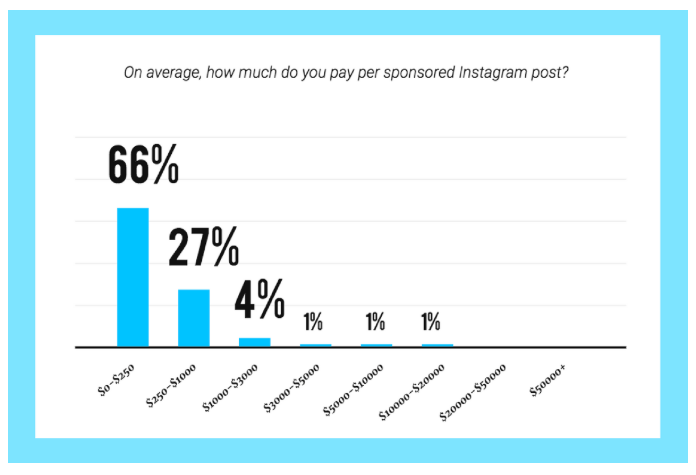
Average Amount Spent on Instagram Social Media Marketing Influencers
Again, these costs are based mainly on follower size.
For example, Selena Gomez – reportedly the highest-paid influencer on Instagram – has 122 million followers and charges 550,000 per post.
Since that’s not in the budget for most of us, let’s look at the media breakdown from one social influencer with 30k followers and a 7.3% engagement rate:
- Dedicated Instagram Post: $325
- IG Giveaway: $350
- Brand IG Takeover (min 2 photos + Stories): $250 per day
- IG Caption Mention (No visible product): $75
- Series of 5 IG Stories: $85
- Series of 3 Dedicated Posts: $825
- Series of 5 Dedicated Posts: $1400
That’s in line with the research we found above and accounts for a wide range of Instagram options.
New research from eMarketer sheds more light on how much Instagram influencers cost. According to that research, the individual influencer fee will depend on the size of his or her following.
So-called nano-influencers (people who only have between 500 and 5,000 followers) earn an average of $114 per post for video content, $43 per post for story content, and $100 per post for image content.
Unsurprisingly, Instagram influencer costs rise even more when they have more followers. Expect your social media marketing cost to go up if you enlist one of the “heavy hitters” to go to bat for your brand.
Power-influencers (people with between 30,000 and 500,000 followers) will charge you, on average, $775 per post for video content, $210 for story content, and $507 for image content.
You can expect your cost to increase dramatically if you enlist the aid of celebrities who have more than 500,000 followers. In that case, you can expect pricing to run into the thousands per post.
YouTube Influencer Marketing Costs Per Post and Follower
Per subscriber: $20 per 1,000 subscribers, or $2,000 per $100,000 followers.
YouTube is generally one of the pricier options. That, understandably, is due to the added time and production costs it takes to produce a full YouTube video.
And costs can add up fast.
Henry Langer, account manager for influencer marketing platform HYPR, told Digiday “For YouTubers with more than 50,000 subscribers, marketers can add roughly $2,000 per 100,000 followers per video, up until around 1 million subscribers, at which point a dedicated video could cost upwards of $25,000-$50,000.”
Per view: $.5-$.10 per view.
You can also look at pricing per view with YouTube.
To get an idea of what this might cost you, Tony Tran of Lumanu recommends looking at an influencer’s 30 most recent videos to see how many views they rack up on average.
The eMarketer study I referenced earlier also states that like Instagram, YouTube pricing is driven by followers (or, in this case, subscriber) count.
Nano-influencers will charge you, on average, $315 per YouTube video. Power-influencers will charge you $782 per video.
As you can see, rates vary not only by channel but also by follower count. Instagram video rates for nano-influencers are quite a bit cheaper than what their counterparts on YouTube will charge. However, they’re roughly the same for power-influencers.
Snapchat Influencer Marketing Costs Per Post and Follower
Per View: $.10-$.35 per view.
Snapchat is a bit trickier.
You might think that since the posts disappear in 24 hours, they would cost less.
Not so.
A solid Snapchat following is hard to build, and Snapchat followers are considered to be the most engaged of any social media platform.
Thus the high price tag.
In fact, it’s not uncommon for brands to pay Snapchat influencers between $500 to $10,000 for a 24-hour campaign.
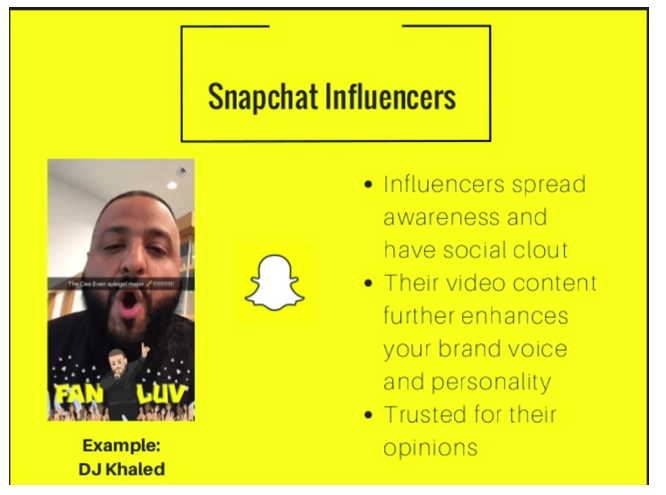
Snapchat Social Media Marketing Influencers
Shaun McBride, a Snapchat influencer with a reported 700,000 followers, told the New York Times it’s not uncommon for someone with his follower count to charge a brand $10,000 for a story.
But because audience size isn’t readily available on the platform, most deals are based on views.
Snapchat influencer Cyrene Quiamco shared the following rates with Digiday:
- $500 for 1,000-5,000 views
- $1,000-$3,000 for 5,000-10,000 views
- $3,000-$5,000 for 10,000-20,000 views
- $5,000-$10,000 for 30,000-50,000 views
- $10,000-$30,000 for 50,000-100,000 views
Facebook Influencer Marketing Costs Per Post and Follower
Facebook influencers could charge an average of $25 per post, per 1000 followers
- An influencer with 10,000 followers could charge $250 per post
- An influencer with 100,000 followers could charge $2500 per post
- An influencer with 1,000,000 followers could charge $25,000 per post
A great thing about Facebook influencer marketing, is that it gets authentically mixed in with users day-to-day content of their family and friends. There are no “sponsored” tags like Facebook Ads shows. This creates a seamless integration into your audience feeds.
Other Considerations
The entire pricing of an influencer marketing campaigns isn’t based solely on the price of the influencer.
To get an idea of the big picture, you have to calculate in all costs associated with the campaign.
That includes any labor costs from you or a team member – researching influencers, contacting them, contract negotiation and campaign strategizing, etc.
It also includes any product samples or content production costs regarding images or other multimedia you may send an influencer for promotion.
To get the most accurate view of your overall costs, try to have a good handle on what the costs to your company will be before adding in the individual influencer fees.
Wrapping Up
Bottom line: there is no cut and dry answer when it comes to influencer marketing costs.
It will vary by channel, industry, follower count, and individual influencer.
But you can have a goal in mind based on the research available, and approach your ideal influencers with what you’ve found to be a fair price.
Influencer Pricing FAQ
1. 💳How much do influencers charge per post?
Influencers on YouTube typically charge $20 per 1,000 subscribers, or $2,000 per $100,000 followers. Influencers on Instagram typically charge $10 per 1,000 followers, or $1,000 per 100,000 followers. Snapchat influencers tend to charge between $.10-$.35 per view and Facebook influencers could charge an average of $25 per post, per 1000 followers.
2. 💸How do I budget for influencer marketing?
In order to budget for an influencer marketing campaign, you should use the following steps:
- First you’ll need to calculate potential conversions by estimating the number of people you think might see the post, and the number of people you think might convert from the influencer’s post.
- Next, calculate LTV + CAC: an average customer’s Lifetime Value and what it would cost to acquire them (CAC). You can use the formula LTV = Cost x Profit Margin x Avg. Customer Lifetime. After you have LTV value, find your CAC assuming that the ideal ratio of CAC:LTV is 1:3 – meaning that for every dollar you spend to acquire a customer, you should be making three times that in the LAT. Do this with the formula CAC= LTV/3
- Finally, calculate your influencer marketing budget for the types of influencers you’re interested in. To do this, multiply the CAC by the number of estimated conversions
3. 💲How much should I pay for influencer marketing?
Influencer marketing pricing can range anywhere from $1000 to $1 million per post, depending on if you’re hiring micro or macro-influencers. Because the pricing can also be negotiable, many businesses and brands seek the help of an agency to help them.
4. 😎Who is the highest paid influencer?
Kylie Jenner is the highest paid social media influencer.
She makes more than $1 million for each sponsored Instagram post.
Jenner has over 164 million Instagram followers.
6. 👓Where can I find TikTok influencers?
There are a few ways to find TikTok influencers:
1. Use hashtags to narrow down the field of influencers to reach your industry, market, or niche.
2. Utilize topics to find influencers who are relevant to your target audience.
3. Find influencers by location.
4. Narrow down influencers by the amount of followers they have.
5. Find influencers by engagement rate.
